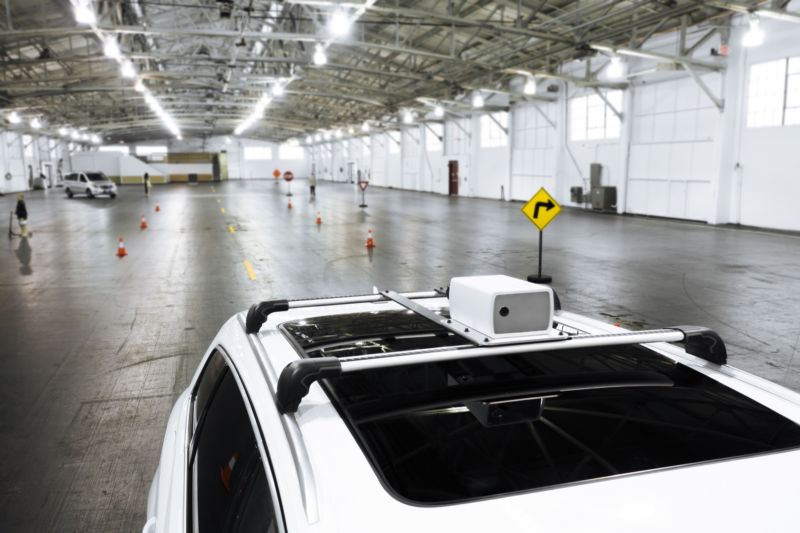
Founded by two veterans of Apple's still-secret driverless car project, Aeva is a startup promising a different kind of lidar—one that can measure the velocity of objects in addition to their distance.
We first covered the company when it was profiled by The New York Times a year ago, but at that time not much was known about how it worked. Now Aeva has unveiled its first lidar sensor, giving us a much better understanding of what the company has been working on.
Traditional lidar sensors, like the ones made by industry leader Velodyne, use a simple time-of-flight approach. They send out a brief pulse of laser light and measure how long it takes for the light to bounce back. This round-trip time translates directly into a distance estimate.
Aeva uses a different approach, known as frequency modulated continuous wave lidar. Instead of sending out fixed pulses, FMCW lidars send out a continuous laser beam with a steadily changing frequency. When the light bounces back, the sensor optically combines the inbound and outgoing light.
Because the frequency is changing at a constant rate, there's a frequency difference between the two beams that's directly proportional to the distance that the returning beam traveled before bouncing back. Combining beams with two slightly different frequencies produces a beat frequency that gives a precise estimate of the frequency difference—and hence a precise distance measurement.
FMCW lidar has some big advantages
This all might sound unnecessarily complicated, but the FMCW approach has some important advantages. Because distance measurements depend on the difference between two constantly changing frequencies, FMCW beams are practically immune from interference. Many FMCW lidars can operate in the same area without worrying about causing confusion. And FMCW lidars work better than time-of-flight lidars in the face of glare from the Sun or other bright light sources.
More importantly, the FMCW approach provides a simple way to measure the velocity of an object as well as its distance. If an object is moving relative to the lidar sensor, this causes a slight frequency change called a redshift that is proportional to the object's velocity in the direction of the beam. With only a single measurement, there's no way to tell how much of the frequency change is due to its distance and how much is due to a velocity-related redshift.
To deal with this issue, standard FMCW lidars take two measurements back to back: one with a rising frequency and then a second with a falling frequency. This flips the sign of the frequency change caused by the distance to the far away object, while the sign of the redshift will be the same for both measurements. From there, it's a matter of simple algebra to figure out the distance and the velocity simultaneously.
That's the approach Aeva is taking—though Aeva may have found a more sophisticated frequency pattern than a simple up-and-down sawtooth. The company tells Ars that it embeds a frequency signature in the beam that allows it to infer both the distance and velocity of objects.
The ability to measure velocity is particularly valuable because a self-driving car obviously needs to pay special attention to non-stationary objects. Most driverless cars also have radar sensors that can measure the velocity of nearby objects, but radar sensors have much lower resolution. Aeva's lidars are able to pinpoint the exact location of surrounding objects and tell whether those objects are moving relative to the background environment.
Other details of Aeva's technology remain unclear. Aeva's lidar is a "solid state" model, meaning that it doesn't mount the entire laser assembly on a spinning gimbal. But Aeva hasn't revealed exactly how its beam-steering technology works—whether it's directing the beam with a tiny mirror or using more exotic techniques like phased arrays.
And while Aeva claims it has a range of 200 meters—potentially long enough to make it competitive with other high-end lidars—the specifics matter here. It's much easier to see highly reflective objects than black, absorbent ones, and Aeva doesn't seem to have provided enough information for an apples-to-apples comparison to other lidars on the market.
Another important question, as industry analyst Brad Templeton points out, is how quickly the product can be produced in volume at a reasonable price. Aeva says that its lidar will cost "a few hundred bucks" in volume. But this is a crowded market, so it matters a lot how quickly Aeva can bring its lidar to market.
Aeva is one of several companies that seem to be working on FMCW lidar. Last year, General Motors acquired a startup called Strobe that appears to be using the same approach. Kyle Vogt, who leads GM's driverless car division, Cruise, touted Strobe's ability to measure distance as well as velocity and its robustness to interference, and one of its cofounders was an academic who did extensive work on FMCW lidars.
Another company called Blackmore is selling what it bills as "the world's first FMCW lidar for automotive." Like Aeva, it claims a 200 meter range and the ability to measure velocity, but, like a lot of other lidar companies, its website doesn't have much information about prices.

reader comments
60